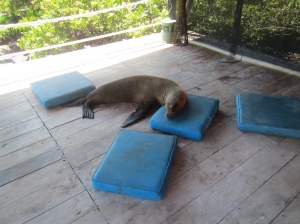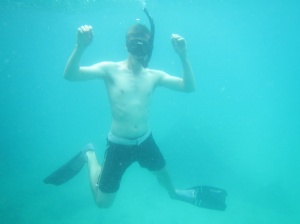Stepping off the plane on Isla Baltra in the Galápagos Islands, the wind immediately accosted my hair, whipping it in every direction. Upon getting my tangled hair under control, I took a moment to look around. I was surprised to find myself on a flat, desert-like island, that was both windy and unbearably hot. This was definitely not how I had envisioned myself hanging out with tortoises and finches! Nevertheless, we made it inside and were greeted by our adorable Ecuadorian guide from our lodge, Red Mangrove. We took a 5 minute bus ride across the tiny island and then boarded an Ecuadorian-style ferry to cross the channel over to Isla Santa Cruz. From there we made our way about 45 minutes across the island to Puerto Ayora, the most inhabited town on Santa Cruz with approximately 15,000 residents. As we crossed the island, we left the flat desert of Baltra behind and began to see lush greenery every which way. Apparently each of the islands has a microclimate, meaning that both the climate and the vegetation is different depending on where you are on the island. Winds blowing from the south bring in humid air, creating a wet climate on the southern most points of the islands, and a dry, arid climate to the north. If that isn’t unique enough, the islands also have many unique plants and animals, including a tree that has a cactus type top, tree finches, and the giant tortoises.

 After a welcome drink, checking into our gorgeous room, and we enjoyed a delicious ocean-side lunch, where we found we were joined a few of the local lizards and sea lions. The lizards are a little creepy, and a little big for my liking, but the sea lions are super cool. They even have a sea lion lounge with pillows for them to relax on! From there, we headed out to get our first taste of Santa Cruz. En route to see the giant tortoises, we stopped to see giant lava sink holes, and to learn all about the geography of these mysterious volcanic islands. I was so excited to see the tortoises that I’m not sure how much of the geography lesson I retained. Finally, we made it to the farm area where the tortoises live, and it was well worth the wait. First of all, they are massive, weighing upwards of 300 kilos. Second of all, they are much more jurassic looking than I had expected. These tortoises are significantly different than any sea turtle I have ever seen, with scaled skin, and archaic faces. Not only do these gentle creatures move Incredibely slow, but they can also live to be hundreds of years old. We set out to find as many as we could, and this didn’t prove to be very difficult considering their size and shape. Respecting the 2 meter rule to ensure we didn’t scare them, we took photos from all angles and admired the way they munched on grass and heaved heavy breaths in and out when lumbering onwards. This was truly one of the most amazing experiences of my whole life. That night, we ate dinner while listening to the waves crash against the nearby rocks, discussing just how cool the giant tortoises were.
After a welcome drink, checking into our gorgeous room, and we enjoyed a delicious ocean-side lunch, where we found we were joined a few of the local lizards and sea lions. The lizards are a little creepy, and a little big for my liking, but the sea lions are super cool. They even have a sea lion lounge with pillows for them to relax on! From there, we headed out to get our first taste of Santa Cruz. En route to see the giant tortoises, we stopped to see giant lava sink holes, and to learn all about the geography of these mysterious volcanic islands. I was so excited to see the tortoises that I’m not sure how much of the geography lesson I retained. Finally, we made it to the farm area where the tortoises live, and it was well worth the wait. First of all, they are massive, weighing upwards of 300 kilos. Second of all, they are much more jurassic looking than I had expected. These tortoises are significantly different than any sea turtle I have ever seen, with scaled skin, and archaic faces. Not only do these gentle creatures move Incredibely slow, but they can also live to be hundreds of years old. We set out to find as many as we could, and this didn’t prove to be very difficult considering their size and shape. Respecting the 2 meter rule to ensure we didn’t scare them, we took photos from all angles and admired the way they munched on grass and heaved heavy breaths in and out when lumbering onwards. This was truly one of the most amazing experiences of my whole life. That night, we ate dinner while listening to the waves crash against the nearby rocks, discussing just how cool the giant tortoises were.
After having one of the better sleeps that I’ve had in a while, we set off to go sea kayaking in the channel between Baltra and Santa Cruz. After nearly being hit by a boat and having a to dodge out of our kayak in Lagos, Portugal, I was a bit weary, but this kayaking proved to be much safer and a great arm workout. We were fortunate enough to see blue-footed boobies (birds!!), a sea turtle, the local mangroves, herons, and other such plants and wildlife. From there, we did some snorkeling, watching schools of fish whiz by in every direction. We also took advantage of my underwater camera and took a few silly selfies!

 After much needed showers and some lunch, we took a boat from Isla Santa Cruz to Isla Isabela, which is the largest island in the Galapagos. As it turned out, our “private” boat was simply a fishing boat. Arriving last on the boat, Ryan and I had the pleasure of sitting in the back of the boat in the prime splash zone. So much for showering! The boat ride started off fairly choppy and I was a little nervous that we were going to have a Playa Blanca boat ride all over again; fortunately, the waves settled within the first 20 minutes and the next hour and a half was fairly pleasant. Or as pleasant as a 2 hour boat ride in the splash zone can be! One benefit of being uncovered was that we were able to see all of our surroundings, including a few of the uninhabited islands of Galapagos. Of the 14 islands, only 4 are inhabited and available for tourists to visit. I found this very interesting, as I had thought that all of the islands were inhabited by indigenous people at the very least.
After much needed showers and some lunch, we took a boat from Isla Santa Cruz to Isla Isabela, which is the largest island in the Galapagos. As it turned out, our “private” boat was simply a fishing boat. Arriving last on the boat, Ryan and I had the pleasure of sitting in the back of the boat in the prime splash zone. So much for showering! The boat ride started off fairly choppy and I was a little nervous that we were going to have a Playa Blanca boat ride all over again; fortunately, the waves settled within the first 20 minutes and the next hour and a half was fairly pleasant. Or as pleasant as a 2 hour boat ride in the splash zone can be! One benefit of being uncovered was that we were able to see all of our surroundings, including a few of the uninhabited islands of Galapagos. Of the 14 islands, only 4 are inhabited and available for tourists to visit. I found this very interesting, as I had thought that all of the islands were inhabited by indigenous people at the very least.
Arriving on Isabela, we were greeted by sea lions sunning themselves on the boats in the pier, the pier itself, as well as the neighboring beach. We were also lucky enough to see a few penguins, which was both awesome and unexpected! After checking in, we gathered for a drink and our nature guide told us more about the history, geography and wildlife of Isabela, and briefed us for the following day. Stay tuned!
Hi Amanda,
Sounds really amazing. Can you remember the name of your boat? Recommend it or not?
Thanks!
Hey!
We took a tour with Red Mangrove, and we did a 4-day Darwin’s Footprint tour. Here is the link to it:
http://www.redmangrovegalapagos.com/land-tours/darwins-triangle-short
It was a really amazing experience and I would definitely recommend it! 🙂
Cheers,
Amanda